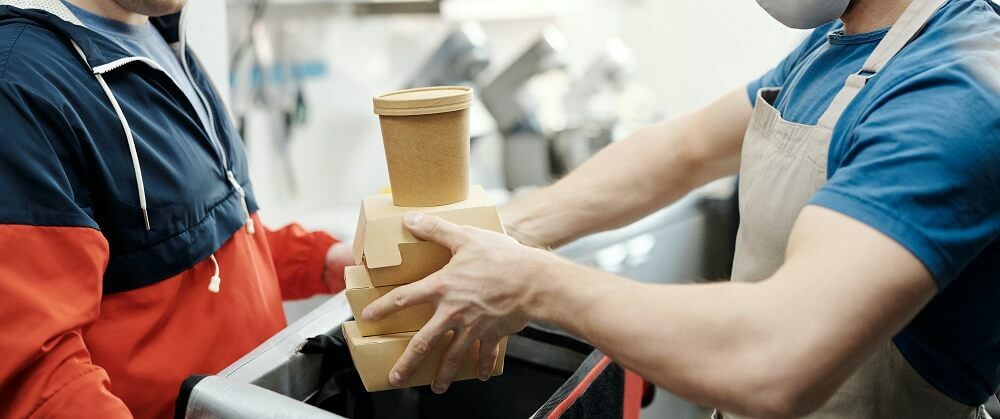In this article, we'll cover:
- What is the difference between upstream versus downstream?
- How are compostable containers meant to be discarded?
- What are the upstream benefits of compostable containers?
- What happens if you just throw away compostable items?
- What about recycled plastic?
What is the difference between upstream versus downstream?
Upstream refers to the functions that occur before a product is used by a consumer. Conversely, downstream refers to what happens after a product has been used and is at the end of its life. For example, upstream benefits of compostable packaging would include the renewable materials containers are made from and how they are produced. Downstream benefits would include what happens to the containers after they've been used to carry food or drinks.

How are compostable containers meant to be discarded?
Compostable packaging is designed to break down into water, CO2, inorganic compounds and biomass. In other words, compostable packaging is intended to break down into nutrient-rich soil so that the original product is not visually distinguishable.
This disintegration process is meant to happen within a set period of time, usually within 90 days at a commercial composting facility or within 12 months in a home compost setting. Some compostable packaging is both home compostable and commercially compostable. Look for certifications like BPI and TÜV AUSTRIA to learn about how a product will breakdown.
Learn more about the differences between home composting and industrial composting in our guide. Locate a composter near you using our map.
What are the upstream benefits of compostable containers?
Even if you don't have commercial composting available in your community, there are still many benefits from using compostables.
Made From Renewable Resources
The first upstream benefit is that compostable food service products come from renewable sources. The products we carry are made from plant-based materials like bamboo, sugarcane fiber, recycled paper, and corn.
Many of the materials used in compostable packaging are made from agricultural byproducts, or what is left over and unused after farming. Fiber from wheat, sugarcane and bamboo farming are prime examples. Previously, the stalks, leaves, and fibrous remnants were burned or left to compost. With compostable packaging, they are put to use to replace materials like foam and plastic while giving farmers and additional revenue stream.
Less Toxic Chemicals
The second benefit is that the production of compostable packaging doesn't involve toxic chemicals used in many traditional plastics. There's the styrene and benzene that workers and consumers are exposed to from polystyrene plastic. The dioxins in our environment from the use of chlorine bleaching of paper. And the small and large oil spills from petroleum extraction. None of these chemicals are issues with plastic alternatives like PLA and PHA.
Fewer Resources Needed To Manufacture
The third benefit is that many sustainable packaging solutions use less energy to produce than their plastic counterparts. For example, making cups with PLA creates 75% fewer greenhouse gases and 50% less non-renewable energy compared to conventional plastic cups made from petroleum.
Making cups with PLA creates 75% fewer greenhouse gases and 50% less non-renewable energy compared to conventional plastic cups made from petroleum.
Sustainable Demand Creates Sustainable Supply
Another benefit consumers get from buying compostable food service products is that it creates and supports demand for more responsible and sustainable products. This rewards manufacturers for continuing to innovate and drives down costs of plastic-free packaging.
It also sends a signal to municipalities to enable more permits to be created for commercial compost facilities to process these products into usable compost instead of filling up landfills.
Educates Consumers & Drives Change
Having consumers use compostable products and read that they are compostable creates awareness and education for compostable materials. This paves the way for drastically reducing plastic and foam use in the future. Use complimentary marketing assets to educate your customers about your choice to use sustainable food packaging.
What happens if you just throw away compostable items?
Unfortunately, compostable containers that are thrown in the trash will most likely end up in a landfill, where they will decompose and emit greenhouse gases. Even food emits methane when its sent to a landfill. The good news is that compostable containers will break down into organic plant-based materials versus plastic containers which break down into smaller microplastics and leech harmful chemicals.
What about using recyclable plastic?
In case you were wondering, using recyclable plastic known as RPET, is not a long-term sustainable answer. Approximately 93% of all the plastic we throw out each year never reaches a recycling facility but ends up in a landfill anyway. Of the small amount that does go into the “recycling” stream, very little comes back in the form in which it originated.
You can safely assume that most plastic in the recycling bin ends up in a landfill because there isn’t a profitable enough market for some plastics to be recycled. It often ends up scrapped and sometimes even incinerated for energy, not turned into another plastic bottle as many people think. Additionally, food residue renders paper and plastic unable to be recycled because of contamination.
Even if commercial composting is not available in your area, there are many reasons to make the switch. It sends the message to your community, governments, and consumers that you care and are willing to drive change.




